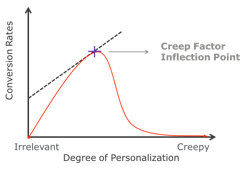
We’ve all felt it at some point. That uncomfortable feeling that someone online knows things about you that you didn’t give them directly or ever intended for them to know. It could be the display ads that keep popping up selling a product related to a search you did last month or maybe the pop up dialog box that wants to chat with you about a website’s services.
Lisa Barnard, Professor of Marketing Communications at Ithaca University, who recently conducted research on the subject with college students, defines this “creepiness” as “the feeling consumers get when they sense an ad is too personal because it uses data the consumer did not agree to give – such as online searches and browsing – and when they’re unclear how and where that information will be used.”
Forrester Research has further defined the continuum of “creepiness” and how it affects an individual’s perceptions of a website or service.

The Creep Factor has increasingly become an issue for digital marketing as marketing technology grows in sophistication and allows for and facilitates highly personalized messaging to prospects and customers. This technology, also known as Online Behaviour Advertising (OBA) enables increasing degrees of personalization and has produced increased success with marketing and sales conversion rates. But we have come to learn through experience that there is a limit to the degree of personalization people are comfortable with, defined below as the Creep Factor Inflection point.
The concept of the creep factor becomes quite clear when you define it in these terms. Too little personalization and you disappoint or miss opportunities. Too much personalization and you very quickly “creep out” your audience and damage your relationship with them.
Professor Barnard’s research confirmed that general targeting was accepted and appreciated by the students but when the targeting became more personal individuals felt uncomfortable. This resulted in a 5% reduction in the student’s intent to purchase the product. Where the exact boundary lies between positive personalized marketing vs negative intrusive marketing remains unclear. More research into these questions is needed in the future to optimize the application of personalized marketing. It also seems to make sense, intuitively, that different demographic groups would have different inflection points, with Digital Natives being more comfortable being more closely tracked and marketed to, versus Baby Boomers, who are generally less digitally experienced.
Marketing Tactics in Recruitment that can Increase the Creep Factor
There is a wide range of marketing activity that can push you into the creepy zone. Some typical examples are:
- Online retargeting advertising – examples like Google Display ads or Social Media retargetting are very common today and are most guilty of giving people that feeling that someone is following them around.
- Home Page Pop Up Chat Windows – trying to engage with prospective students when they hit your home page is understandable but too much, too soon can cause a negative effect.
- Tracking of prospective student engagement with marketing automation tools – Tools like HubSpot give marketers an incredible amount of detail on visitor touchpoints, engagement and history by assigning unique identifiers to an individual and tracking them across multiple platforms and channels. If applied too enthusiastically, these capabilities can easily push prospects to Forrester’s “Freaked” stage.

How to Avoid the Creep Factor in your Marketing
Marketing personalization is a double edged sword that can cut both ways. You can avoid being creepy by:
- Giving notice at various points of interaction with your prospects that you do track site interaction in an effort to improve your user’s experience and to provide them with customized and appropriate content
- Create customized funnels for specific personas with appropriate content and messaging that provides a visitor with highly appropriate interactions
- Be respectful in your means of engagement and communications and don’t project that you know more about your prospects than is appropriate to their stage in the recruitment funnel
- Avoid fake intimacy
- Don’t be too specific, ignoring some of the detailed info you have
- Engage the prospect in direct communications, building trust. If your marketing does go over the line, It’s less likely that they will be creeped out by someone that they are talking to, that they have a relationship with.
- Limit your message frequency to levels that remind versus creep out.
Marketing personalization provides great opportunities to engage with prospects and improve your marketing ROI and “conversions to student” in the recruitment funnel. By taking a measured, respectful approach to this increasingly powerful technology you can can avoid the creep factor and stay on the positive side of the Creep factor curve.
What practices and policies has your institution adopted to manage the Creep factor? What are the most important lessons you have learned?







